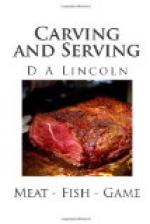Capons and large fowls may be sliced thinly across the breast in the same manner as a roast turkey. But if the fowl be small, draw the knife along the edge of the breast-bone on each side, and lay the meat away from the bone; the fillets will separate easily. Then divide the meat across the grain. Separate the collar-bone from the breast. Slip the knife under the shoulder-blade, turn it over, and separate at the joint. Cut through the cartilage connecting the ribs; this will separate the breast from the back. Now remove the fork from the breast, turn the back over, place the knife midway, and with the fork lift up the tail end, separating the back from the body. Place the fork in the middle of the backbone, cut close to the backbone from one end to the other on each side, freeing the side-bones.
The wing and breast of a boiled fowl are the favorite portions. It is important that the fowl be cooked just right. If underdone, the joints will not separate readily; and if overdone they will fall apart so quickly that carving is impossible. Unless the knife be very sharp, and the work done carefully, the skin of the breast will come off with the leg or wing.
BROILED CHICKEN.
Split the chicken down the back and remove the backbone. If the chicken be very young and tender—and only such are suitable for broiling—remove the breast-bone before cooking, or cut the bone through the middle, lengthwise and crosswise from the inside, without cutting into the meat. In serving, divide through the breast from the neck down, and serve half to each person; or if a smaller portion be desired, divide each half crosswise through the breast, leaving the wing on one part and the leg on the other.
If the chicken be large, break the joints of the legs, thighs, and wings, without breaking through the skin; cut the tendons on the thighs from the inside, cut the membrane on the inside of the collar-bone and wing-joint, and remove the breast-bone. This may all be done before cooking, and will not injure the appearance of the outside.
In serving, separate the legs and wings at the joints, then separate the breast from the lower part, and divide the breast lengthwise and crosswise.
Carving-scissors are convenient for cutting any kind of broiled game or poultry.
ROAST TURKEY.
Turkeys should be carefully trussed. The wings and thighs should be brought close to the body and kept in position by skewers. The ends of the drumsticks may be drawn into the body or crossed over the tail and tied firmly.
After cooking, free the ends of the drumsticks from the body and trim them with a paper ruffle. This will enable the carver to touch them if necessary without soiling his hands. Place the turkey on the platter with the head at the left. Unless the platter be very large, provide an extra dish, also a fork for serving.




